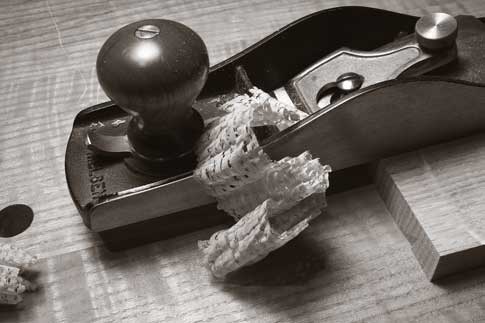
Somehow, during the course of about five years, I became a math dolt. When I left high school, my SAT scores for math were near perfect – far higher than my verbal score.
But after four years of studying intransitive verbs, subjunctive mood and zeugmas, my math skills withered to the point where – no lie – I couldn’t figure out the formula for the perimeter of a pentagon during a college class we all called “Math for Trees.” My wife still mocks me for this.
So I’ve always been at a loss to explain to readers the different curve required on the blade of a bevel-up smoothing plane vs. the curve required for a bevel-down smoothing plane.
The brain-dolt answer was always: The bevel-up planes require more curve to take the same shaving as a bevel-down smoothing plane. But that was about as good as my explanation got.
A couple weekends ago, David Powell explained the math to me during a presentation at the Northeastern Woodworkers Association’s Woodworkers Showcase. I retained the explanation and formula only until the next morning. (Honest: I had only one beer that night. Perhaps is was the lamb korma.)
In any case, I took notes during the presentation that are useful for the shop. If anyone wants the formulas, you can probably ask Powell himself. Powell was the founder of Diamond Machining Technology (DMT) and is now the maker of the Odate Crowning Plates. The plates are diamond stones with a curve built into them so you don’t have to use finger pressure to create the curve on the blade.
Powell’s numbers assume that the iron has a curve created by one of his diamond crowning plates. The plates are dished to mimic a 37-1/2’-radius circle. Powell’s numbers also assume you are using 90 percent of the iron of the tool during the cut.
So here goes: A bevel-down No. 4 handplane with a 2”-wide iron that is bedded at 45° will take a .002”-thick shaving if it has an iron that is sharpened with the Odate crowning plate.
Now let’s take a bevel-up low-angle block plane with its 1-3/8”-wide iron bedded at 12° and the iron sharpened at 25° (the angle of attack is therefore 37°). Powell says this plane will take a .0005”-thick shaving if you use 90 percent of the iron in the cut.
How about the very popular bevel-up jack plane? It has a 2-1/8”-wide iron and also is bedded bevel-up at 12°. If you have a 25° bevel sharpened on the iron, it will take a .0008”-thick cut. If you have a 38° bevel sharpened on the iron, the plane will take a .0006”-thick cut. And if you have a 50° bevel sharpened on the iron, the plane will take a .0004”-thick cut.
While these numbers don’t tell you how much extra pressure to put at the corners of your iron to make that extra curve, there is a good piece of data here. And here it is: Use the same curve for all your smoothing planes.
A plane bedded at 45° is best suited for mild woods. So its .002”-thick shaving is about right.
Planes bedded at higher angles are used for curly, exotic or just grumpy woods. So the best strategy is to take a thinner shaving (thinner shavings help reduce tear-out in my experience). So a shaving thinner than .001” is an excellent choice. And that’s exactly what you’ll get with a high pitch.
So all that math boiled down to this: Don’t bother with the math. Just stick with the same curve for bevel-up or bevel-down and you’ll be OK.
— Christopher Schwarz